400-998-5282
专注多肽 服务科研
400-998-5282
专注多肽 服务科研

编号:110316
CAS号:
单字母:Biotinyl-EGPWLEEEEEA-pTyr-GWMDF-CONH2
胃泌素(Gastrin)的定义
胃泌素是胃酸分泌的主要生理调节剂。它对胃粘膜也有重要的营养或生长促进作用。
Gastrin is a major physiological regulator of gastric acid secretion. It also has an important trophic or growth-promoting influence on the gastric mucosa.
胃泌素(Gastrin)的相关肽
前胃泌素在胃窦G细胞中合成并加工成许多生物活性肽。七肽胃泌素-17是主要产物(胃泌素成分3或少量胃泌素),也称为胆囊收缩素B【1】。胃泌素-17酰胺对应于前胃泌素-(55-71)。甘氨酸延伸的非硫酸化胃泌素-17对应于前胃泌素-(55-72)。胃泌素-17的一小部分在G细胞中被切割并作为短COOH末端肽释放,作为胃泌素-7,胃泌素-6和胃泌素-5的混合物【2】。硫酸化胃泌素-6是释放到窦静脉血中的主要形式。胃泌素6比胃泌素17具有更高的效力但功效更低。酪氨酸O-硫酸化增加了胃泌素-6的功效,这也增强了对消除的保护作用。隐球菌素对应于前胃泌素-(1-35)。隐球菌素-(6-35)(前胃泌素-(6-35))是该肽的较短形式【3】。两种最大的α-羧酰胺化胃泌素前体产物是胃泌素71和胃泌素52。胃泌素-52具有生物活性,其功效接近或类似于胃泌素-17【4】。胃泌素成分1是胃泌素的最大激素活性形式,并且已显示对应于胃泌素71。胃泌素-14被称为胃泌素成分4或微胃泌素【5】。五肽胃泌素对应于胃泌素的五个C末端氨基酸,与CCK-5(胆囊收缩素-5)相同,CCK-5主要通过B型胆囊收缩素受体起作用。
Progastrin is synthesized in antral G cells and processed into a number of bioactive peptides. The heptadecapeptide gastrin-17 is the main product (Gastrin component 3 or little Gastrin), called also Cholecystokinin B【1】. Gastrin-17 amide corresponds to Progastrin-(55-71). Glycine-extended nonsulfated gastrin-17 corresponds to Progastrin-(55-72). A minor fraction of gastrin-17 is cleaved in G cells and released as short COOH-terminal peptides, as a mixture of gastrin-7, gastrin-6, and gastrin-5【2】. The sulfated gastrin-6 is the predominant form released to antral venous blood. Gastrin 6 has a higher potency but a lower efficacy than gastrin-17. The efficacy of gastrin-6 is increased by tyrosine O-sulfation, which also enhances the protection against elimination. Cryptagastrin corresponds to progastrin-(1-35). Cryptagastrin-(6-35) (progastrin-(6-35) is a shorter form of this peptide【3】. The two largest alpha-carboxyamidated progastrin products are gastrin-71 and gastrin-52. Gastrin-52 is bioactive with an efficacy close to or similar to that of gastrin-17【4】. Gastrin component 1 is the largest hormonally active form of gastrin and has been shown to correspond to gastrin-71. Gastrin-14 has been termed gastrin component 4 or minigastrin【5】. Pentagastrin corresponds the five C-terminal amino acids of gastrin and is the same as CCK-5 [cholecystokinin-5], which acts mainly through the type B cholecystokinin receptor.
胃泌素(Gastrin)的发现
胃泌素最初由Edkins和Cantab于1905【6】年鉴定,是胃窦中产生的一种刺激胃酸分泌的因子。它是从猪胃窦粘膜中纯化出来的,并于1964年由Gregory和Tracy测序【7】。
Gastrin was identified originally by Edkins and Cantab in 1905【6】, as a factor produced in the antrum of the stomach that stimulates gastric acid secretion. It was purified from hog antral mucosa and sequenced by Gregory and Tracy in 1964【7】.
胃泌素(Gastrin)的结构特征
胃泌素是一种线性肽,合成为前胃泌素,前胃泌素,在胃窦G细胞中加工成许多不同长度的生物活性胃泌素,它们具有相同的含有活性位点的α-酰胺化C末端。胃泌素的活性位点是羧基末端四肽酰胺Trp-Met-Asp-Phe-NH2,所有生物活性片段都具有羧基末端六序列Tyr(SO4)-Gly-Trp-Met-Asp-Phe-NH2。氨基末端延伸的长度控制循环激素形式的代谢和清除。所有生物活性胃泌素肽都是羧酰胺化的,以非硫酸化和硫酸化形式存在【8】。
Gastrin is a linear peptide that is synthesized as a preprohormone, Progastrin, which is processed in antral G cells to a number of bioactive gastrins of different length, which share the same alpha-amidated C-terminus containing the active site. The active site of gastrin is the carboxyterminal tetrapeptide amide Trp-Met-Asp-Phe-NH2 and all bioactive fragments have the carboxyterminal hexasequence Tyr (SO4)-Gly-Trp-Met-Asp-Phe-NH2. The lengths of the aminoterminal extensions govern metabolism and clearance of the circulating hormone forms. All bioactive gastrin peptides are carboxyamidated and exist in nonsulfated and sulfated forms【8】.
胃泌素(Gastrin)的作用机制
胃泌素受体也是结合胆囊收缩素的受体之一,被称为CCK-B受体。它是G蛋白偶联受体家族的成员。胃泌素的结合刺激细胞内Ca++的增加,蛋白激酶C的激活和肌醇磷酸的产生【9】。
The gastrin receptor is also one of the receptors that bind cholecystokinin, and is known as the CCK-B receptor. It is a member of the G protein-coupled receptor family. Binding of gastrin stimulates an increase in intracellular Ca++, activation of protein kinase C, and production of inositiol phosphate【9】.
胃泌素(Gastrin)的功能
胃泌素似乎对胃肠功能至少有两个主要影响:
Gastrin appears to have at least two major effects on gastrointestinal function:
1、刺激胃酸分泌:胃泌素受体存在于壁细胞上,胃泌素与组胺和乙酰胆碱的结合导致这些细胞完全刺激酸分泌。肠嗜铬样(ECL)细胞也携带胃泌素受体,最近的证据表明,该细胞可能是胃泌素调节酸分泌的最重要靶标。胃泌素刺激ECL细胞导致组胺释放,组胺与壁细胞上的H2受体结合是全面分泌酸所必需的。
1. Stimulation of gastric acid secretion: Gastrin receptors are found on parietal cells, and binding of gastrin, along with histamine and acetylcholine, leads to fully-stimulated acid secretion by those cells. Enterochromaffin-like (ECL) cells also bear gastrin receptors, and recent evidence indicates that this cell may be the most important target of gastrin with regard to regulating acid secretion. Stimulation of ECL cells by gastrin leads to histamine release, and histamine binding to H2 receptors on parietal cells is necessary for full-blown acid secretion.
2、促进胃粘膜生长:胃泌素显然具有刺激胃粘膜发育和生长的许多方面的能力。胃泌素治疗可刺激胃粘膜中的DNA,RNA和蛋白质合成,并增加壁细胞的数量。支持这一功能的另一个观察结果是,患有高胃泌素血症(胃泌素异常高的血液水平)的人始终表现出胃粘膜肥大。
2. Promotion of gastric mucosal growth: Gastrin clearly has the ability to stimulate many aspects of mucosal development and growth in the stomach. Treatment with gastrin stimulates DNA, RNA and protein synthesis in gastric mucosa and increases the number of parietal cells. Another observation supporting this function is that humans with hypergastrinemia (abnormally high blood levels of gastrin) consistently show gastric mucosal hypertrophy.
除了壁细胞和ECL细胞靶标外,胃泌素还通过与胆囊收缩素受体结合来刺激胰腺腺泡细胞,并且已经在某些胃平滑肌细胞群上证实了胃泌素受体,这支持了药理学研究,证明了胃泌素在调节胃动力中的作用。
In addition to parietal and ECL cell targets, gastrin also stimulates pancreatic acinar cells via binding to cholecystokinin receptors, and gastrin receptors have been demonstrated on certain populations of gastric smooth muscle cells, supporting pharmacologic studies that demonstrate a role for gastrin in regulating gastric motility.
胃泌素(Gastrin)的相关文献
1. Morley JS, Tracy HJ, Gregory RA (1965). Structure-function relationships in the active C-terminal tetrapeptide sequence of gastrin. Nature, 207, 1356-1359.
2. Rehfeld JF, Hansen CP, Johnsen AH (1995). Postpoly(Glu) cleavage and degradation modified by O-sulfated tyrosine: a novel posttranslational processing mechanism. EMBO Journal, 14, 389-396.
3. Huebner VD, Jiang RL, Lee TD, Legesse K, Walsh JH, Shively JE, Chew P, Azumi T, Reeve JR Jr (1991). Purification and structural characterization of progastrin-derived peptides from a human gastrinoma. J Biol. Chem., 266(19), 12223-12227.
4. Hansen CP, Stadil F, Rehfeld JF (1995). Metabolism and influence of gastrin-52 on gastric acid secretion in humans. Amer. J of Physiol., 269(4 Pt 1), G600-605.
5. Gregory RA, Tracy HJ, Harris JI, Runswick MJ, Moore S, Kenner GW, Ramage R (1979). Minigastrin: corrected structure and synthesis. Hoppe Seylers Zeitschrift für Physiologische Chemie, 360, 73-80.
6. Edkin JS and Cantab MB (1905). On the chemical mechanism of gastric secretion. Proc. of the Royal Society London, 76, 376.
7. Gregory H, Hardy PM, Jones DS, Kenner GW, Sheppard RC (1964). The antral hormone gastrin. Structure of gastrin. Nature, 204, 931-3.
8. Rehfeld JF and Larsson LI (1979). The predominating molecular form of gastrin and cholecystokinin in the gut is a small peptide corresponding to their COOH-terminal tetrapeptide amide. Acta Physiologica Scandinavia, 115, 117-119.
9. Dockray GJ (1999). Topical review. gastrin and gastric epithelial physiology. J Physiol., 518(2), 315-324.
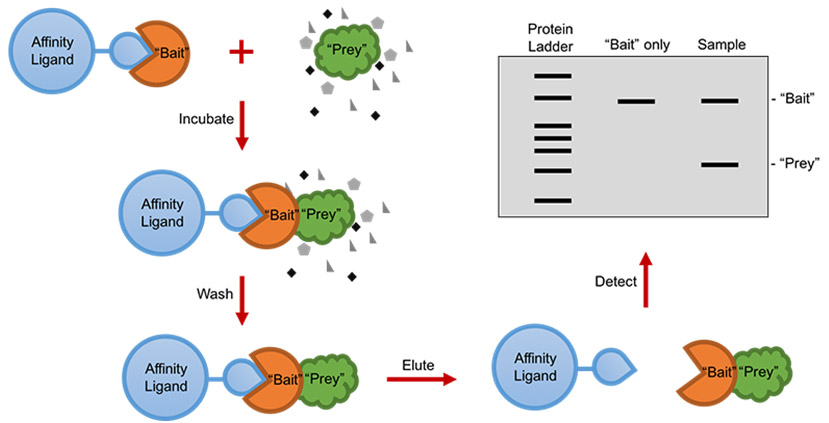
生物素可以与亲和素或者链霉亲和素有力结合,结合强度甚至接近共价键。生物素标记的肽通常用于免疫测定,组织细胞化学和基于荧光的流式细胞术。标记的抗生物素抗体也可以用来结合生物素化多肽。生物素标记常连接在赖氨酸侧链或者N末端。通常在多肽和生物素之间使用6-氨基己酸作为纽带,纽带能够灵活结合底物,并且在有空间位阻的情况下能结合地更好。专肽生物根据需求,向客户提供具有不同位点生物素标记多肽的定制合成。
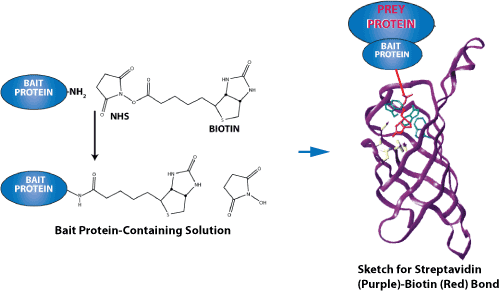
专肽生物合成用于蛋白质-蛋白质相互作用研究的生物素化肽。尽管生物素可以在 N 端或 C 端引入(通过赖氨酸残基),但我们建议使用 N 端修饰,因为它成本低、成功率高、周转时间短且易于操作。因为多肽合成是从 C 端到 N 端合成的,因此,N 端修饰是 SPPS步骤的最后一步,不需要额外的特定缩合步骤。相比之下,C 端修饰需要额外的步骤,并且通常更复杂。当然,原则上生物素可以定位在任何地方。

生物素可以通过多种不同的接头或间隔物与肽分离。尽管如此,还是建议包含一个灵活的间隔物,例如 Ahx(一个 6 碳接头),以使生物素标签更加稳定或灵活。
专肽生物在 N 端或 C 端提供生物素化:生物素-N 端、赖氨酸-生物素-肽中间和赖氨酸-生物素-C 端。
专肽生物还可以使用 Ahx 接头或长碳 (LC) 接头提供生物素化:生物素-Ahx-N 末端、Lys-Ahx-生物素-肽中间、Lys-Ahx-生物素-C-末端。

(生物素结构)
示例:
GRGDS在N端和C端标记生物素的结构展示。
1、GRGDS在N端标记生物素,不增加Ahx 接头

2、GRGDS在N端标记生物素,增加一个Ahx 接头

3、GRGDS在C端标记生物素,不增加Ahx 接头
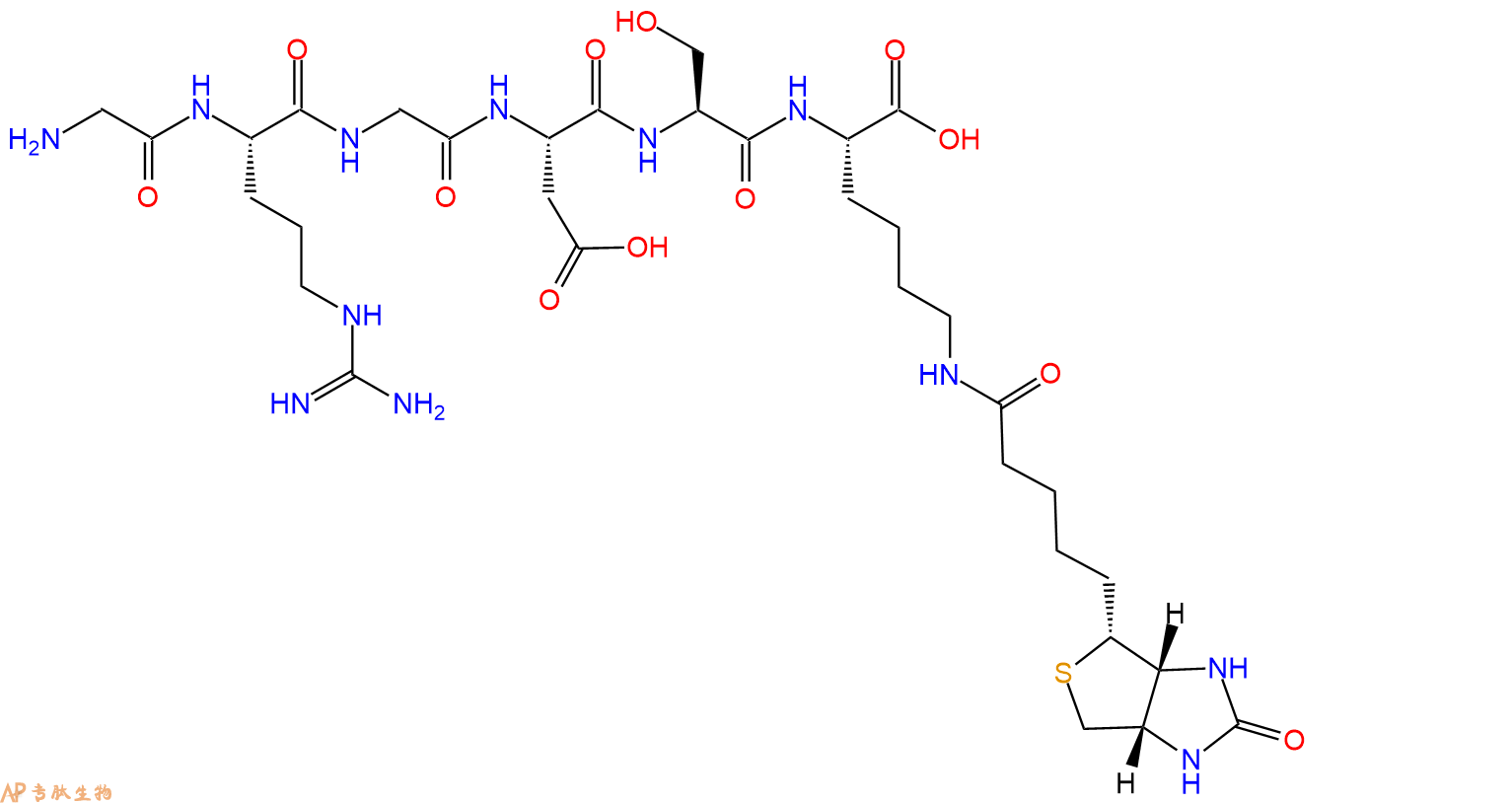
4、GRGDS在C端标记生物素,增加一个Ahx 接头。
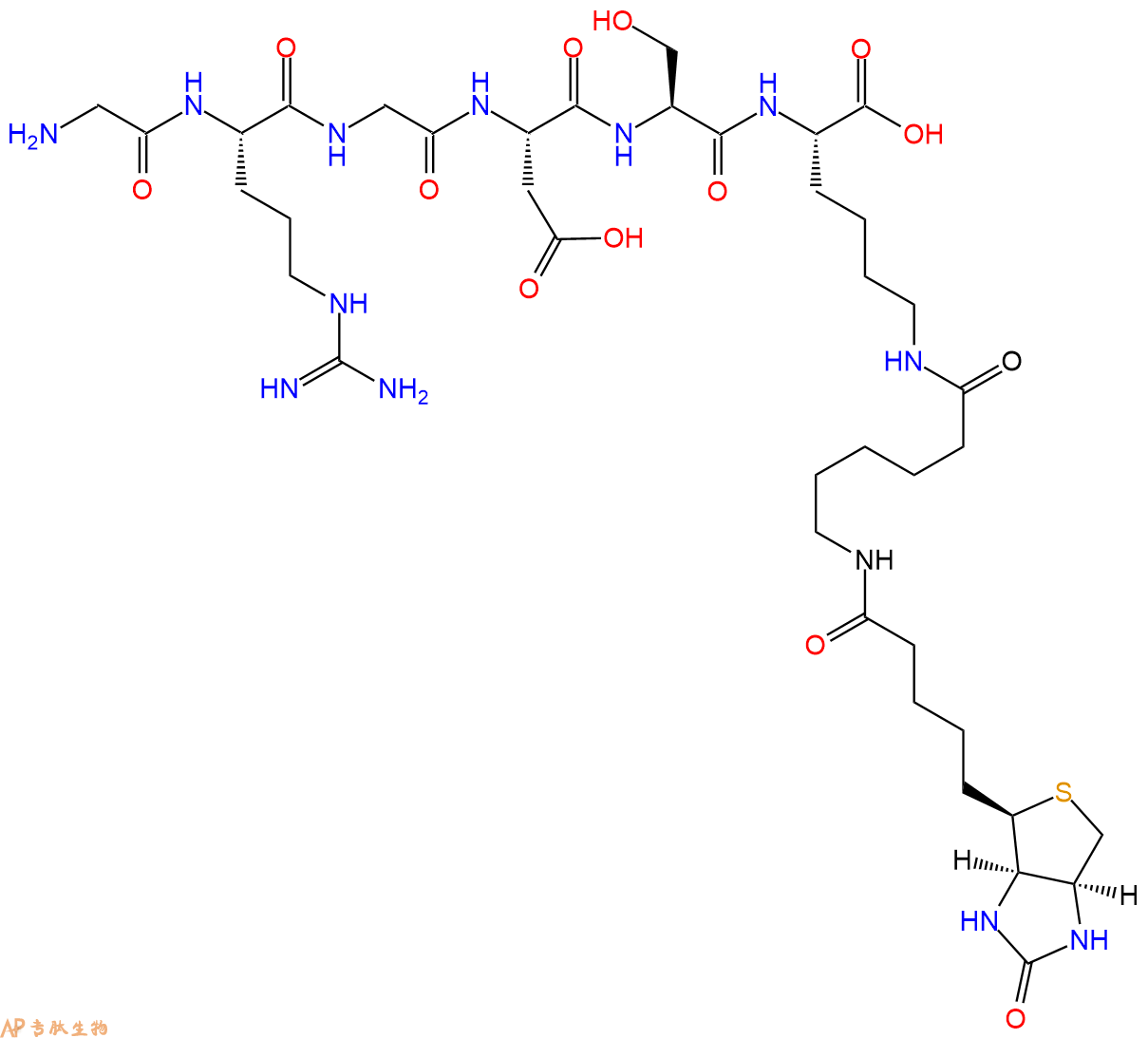
磷酸肽的合成
在生命过程中发挥重要作用,磷酸化的位置在多肽上的Tyr、Ser,Thr,。目前磷酸肽合成一般都采用磷酸化氨基酸,目前使用的都是单苄基磷酸化氨基酸。磷酸化氨基酸的连接一般采用HBTU/HOBt/DIEA方法,但是目前采用该方法合成磷酸化多肽也有缺点,特别是在合成多磷酸化多肽或氨基酸较长的多肽的时候,连接效率低,最后产品纯度很低,对于这种磷酸化多肽,我们考虑采用后磷酸化方法,其合成过程就是在多肽合成结束后,选择性脱去要标记的氨基酸的侧链保护基,对于Tyr,Thr可以直接使用侧链不保护的氨基酸进行反应,而Ser可以采用Fmoc-Ser(trt),在1% TFA/DCM条件下可以定量的脱除。后磷酸化,采用双苄基亚磷酰胺,四氮唑生成亚磷酰胺四唑活性中间体,连接到羟基上,随后在过氧酸下氧化生成磷酰基,完成反应。
目前,多肽的磷酸化修饰方法主要有两种:
(1)将适当保护的磷酸化氨基酸直接引入到多肽序列中;
(2)多肽序列在树脂上合成完后,再对其中的Ser、Tyr或Thr的侧链羟基进行磷酸化。
1)将适当保护的磷酸化氨基酸直接引入到多肽序列中:
即事先将需要磷酸化的氨基酸(Thr,Ser或Tyr)磷酸化并适当保护,然后按照正常SPPS 合成流程将磷酸化单体缩合到多肽指定位点。这种方法操作简便,已经成为多肽单位点 磷酸化修饰的主要方法。

2)多肽序列在树脂上合成完后,再对其中的Ser、Tyr或Thr的侧链羟基进行磷酸化:
采用将磷酸化单体缩合到多肽中的方法进行磷酸化修饰时,磷酸化的氨基酸由于侧链修 饰的较大基团产生的位阻而导致难以与肽链缩合,并且之后的氨基酸引入都会比较困难, 尤其在含有多个磷酸化位点修饰时,合成将变得异常困难,并且最终产物成分复杂,难 以分离,产率极低。
因此,当肽链中多个位点进行磷酸化时,可以考虑采用将多肽序列 在树脂上合成完后,再对其中的Ser、Tyr或Thr的侧链羟基进行磷酸化:其合成过程主要 就是在多肽合成结束之后,选择性的脱去要标记氨基酸的侧链保护基,对于Tyr,Thr可 以直接使用侧链不保护的氨基酸进行反应。
侧链保护基在1%TFA/DCM条件下可以定量的脱 除。采用这种方法时,可以采用双苄基亚磷酰胺,四氮唑生成亚磷酰胺四唑活性中间体, 连接到羟基上,然后在过氧酸条件下氧化生成磷酰基,完成反应。
磷酸肽的的介绍
在所有的PTM中,磷酸化是最丰富和最重要的修饰之一。磷酸基团是一个高度带负电的分子,在磷原子周围有一个四面体结构。磷酸化多肽主要指肽链中的Ser、Tyr和Thr 残基的侧链羟基被修饰成酸式磷酸酯多肽。许多激素均是通过提高丝氨酸(Ser)或苏氨酸(Thr)残基的磷酸化状态来调节特异性酶的活性。磷酸化与人类疾病高度相关。例如,tau、α-synuclein和huntingtin的过度/多重磷酸化与人类疾病高度相关,聚集磷酸化也爆发神经退行性疾病的主要原因之一,例如阿尔茨海默氏病、帕金森氏病和亨廷顿氏病。目前,对磷酸化氨基酸的主要研究集中在羟基磷酸单酯型磷酸化氨基酸(O-磷酸化氨基酸),即磷酸化丝氨酸,磷酸化苏氨酸,磷酸化酪氨酸。
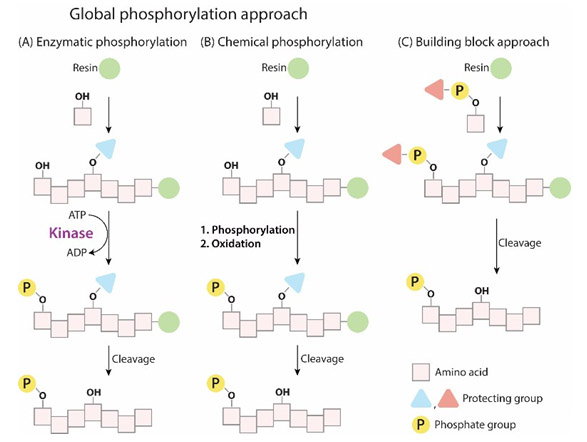
专肽生物生物为客户提供pSer、pTyr、pThr和D-pSer、D-pTyr、D-pThr的磷酸化修饰服务,也可以进行二、三、四、五个磷酸化位点修饰的高质量多肽的合成。
多肽Biotin-Glu-Gly-Pro-Trp-Leu-Glu-Glu-Glu-Glu-Glu-Ala-Tyr(PO3H2)-Gly-Trp-Met-Asp-Phe-NH2的合成步骤:
1、合成MBHA树脂:取若干克MBHA树脂(如初始取代度为0.5mmol/g)和1倍树脂摩尔量的Fmoc-Linker-OH加入到反应器中,加入DMF,搅拌使氨基酸完全溶解。再加入树脂2倍量的DIEPA,搅拌混合均匀。再加入树脂0.95倍量的HBTU,搅拌混合均匀。反应3-4小时后,用DMF洗涤3次。用2倍树脂体积的10%乙酸酐/DMF 进行封端30分钟。然后再用DMF洗涤3次,甲醇洗涤2次,DCM洗涤2次,再用甲醇洗涤2次。真空干燥12小时以上,得到干燥的树脂{Fmoc-Linker-MHBA Resin},测定取代度。这里测得取代度为 0.3mmol/g。结构如下图:

2、脱Fmoc:取1.1g的上述树脂,用DCM或DMF溶胀20分钟。用DMF洗涤2遍。加3倍树脂体积的20%Pip/DMF溶液,鼓氮气30分钟,然后2倍树脂体积的DMF 洗涤5次。得到 H2N-Linker-MBHA Resin 。(此步骤脱除Fmoc基团,茚三酮检测为蓝色,Pip为哌啶)。结构图如下:
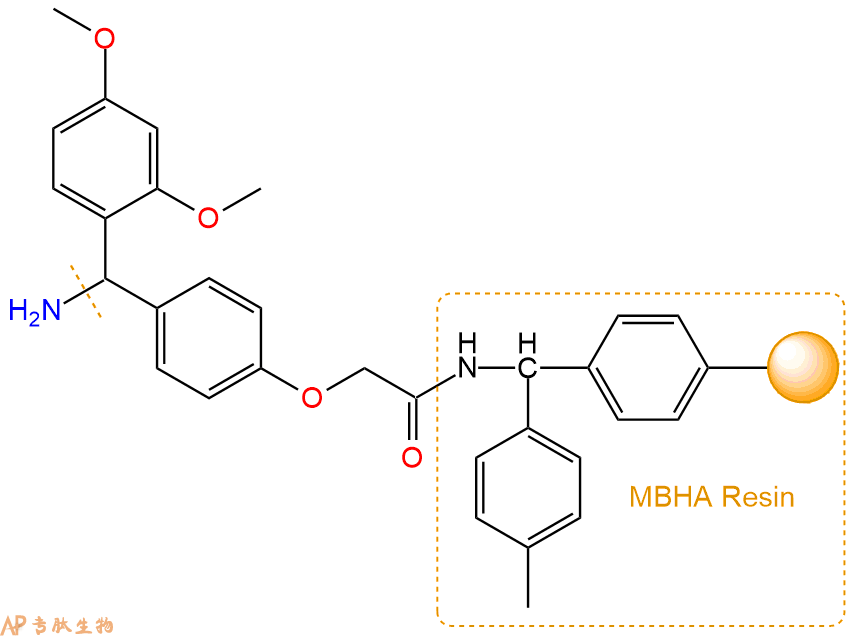
3、缩合:取0.99mmol Fmoc-Phe-OH 氨基酸,加入到上述树脂里,加适当DMF溶解氨基酸,再依次加入1.98mmol DIPEA,0.94mmol HBTU。反应30分钟后,取小样洗涤,茚三酮检测为无色。用2倍树脂体积的DMF 洗涤3次树脂。(洗涤树脂,去掉残留溶剂,为下一步反应做准备)。得到Fmoc-Phe-Linker-MBHA Resin。氨基酸:DIPEA:HBTU:树脂=3:6:2.85:1(摩尔比)。结构图如下:
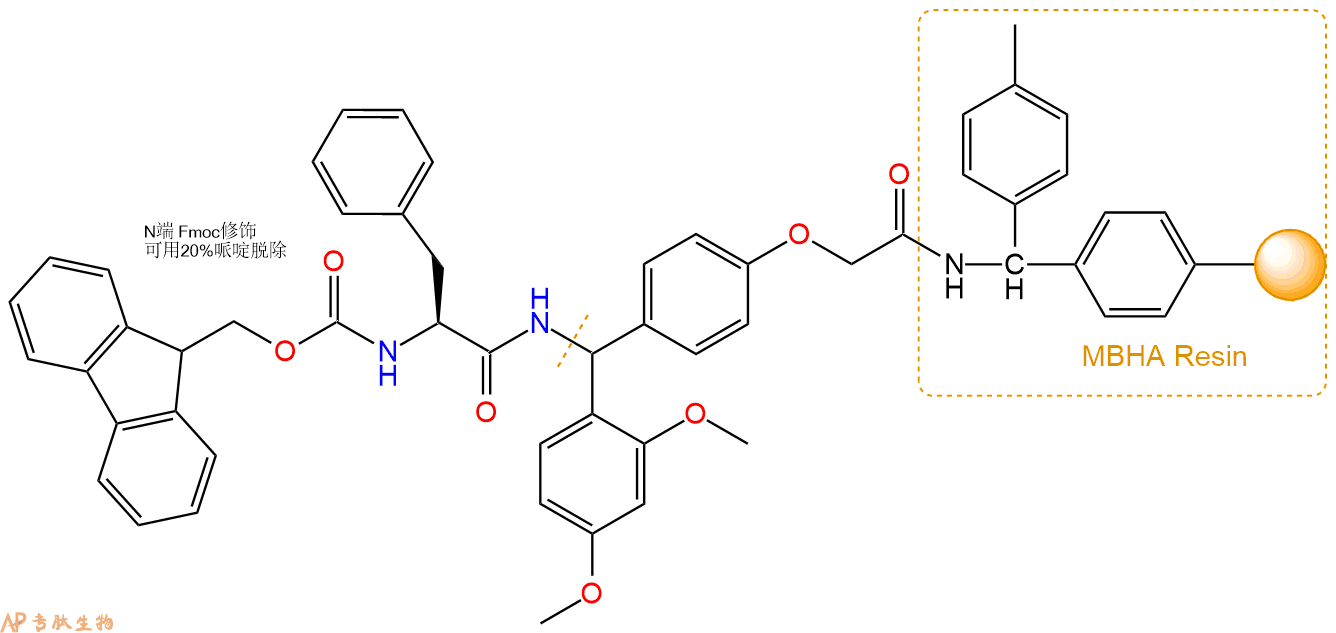
4、依次循环步骤二、步骤三,依次得到
H2N-Phe-Linker-MBHA Resin
Fmoc-Asp(OtBu)-Phe-Linker-MBHA Resin
H2N-Asp(OtBu)-Phe-Linker-MBHA Resin
Fmoc-Met-Asp(OtBu)-Phe-Linker-MBHA Resin
H2N-Met-Asp(OtBu)-Phe-Linker-MBHA Resin
Fmoc-Trp(Boc)-Met-Asp(OtBu)-Phe-Linker-MBHA Resin
H2N-Trp(Boc)-Met-Asp(OtBu)-Phe-Linker-MBHA Resin
Fmoc-Gly-Trp(Boc)-Met-Asp(OtBu)-Phe-Linker-MBHA Resin
H2N-Gly-Trp(Boc)-Met-Asp(OtBu)-Phe-Linker-MBHA Resin
Fmoc-Tyr(HPO3Bzl)-Gly-Trp(Boc)-Met-Asp(OtBu)-Phe-Linker-MBHA Resin
H2N-Tyr(HPO3Bzl)-Gly-Trp(Boc)-Met-Asp(OtBu)-Phe-Linker-MBHA Resin
Fmoc-Ala-Tyr(HPO3Bzl)-Gly-Trp(Boc)-Met-Asp(OtBu)-Phe-Linker-MBHA Resin
H2N-Ala-Tyr(HPO3Bzl)-Gly-Trp(Boc)-Met-Asp(OtBu)-Phe-Linker-MBHA Resin
Fmoc-Glu(OtBu)-Ala-Tyr(HPO3Bzl)-Gly-Trp(Boc)-Met-Asp(OtBu)-Phe-Linker-MBHA Resin
H2N-Glu(OtBu)-Ala-Tyr(HPO3Bzl)-Gly-Trp(Boc)-Met-Asp(OtBu)-Phe-Linker-MBHA Resin
Fmoc-Glu(OtBu)-Glu(OtBu)-Ala-Tyr(HPO3Bzl)-Gly-Trp(Boc)-Met-Asp(OtBu)-Phe-Linker-MBHA Resin
H2N-Glu(OtBu)-Glu(OtBu)-Ala-Tyr(HPO3Bzl)-Gly-Trp(Boc)-Met-Asp(OtBu)-Phe-Linker-MBHA Resin
Fmoc-Glu(OtBu)-Glu(OtBu)-Glu(OtBu)-Ala-Tyr(HPO3Bzl)-Gly-Trp(Boc)-Met-Asp(OtBu)-Phe-Linker-MBHA Resin
H2N-Glu(OtBu)-Glu(OtBu)-Glu(OtBu)-Ala-Tyr(HPO3Bzl)-Gly-Trp(Boc)-Met-Asp(OtBu)-Phe-Linker-MBHA Resin
Fmoc-Glu(OtBu)-Glu(OtBu)-Glu(OtBu)-Glu(OtBu)-Ala-Tyr(HPO3Bzl)-Gly-Trp(Boc)-Met-Asp(OtBu)-Phe-Linker-MBHA Resin
H2N-Glu(OtBu)-Glu(OtBu)-Glu(OtBu)-Glu(OtBu)-Ala-Tyr(HPO3Bzl)-Gly-Trp(Boc)-Met-Asp(OtBu)-Phe-Linker-MBHA Resin
Fmoc-Glu(OtBu)-Glu(OtBu)-Glu(OtBu)-Glu(OtBu)-Glu(OtBu)-Ala-Tyr(HPO3Bzl)-Gly-Trp(Boc)-Met-Asp(OtBu)-Phe-Linker-MBHA Resin
H2N-Glu(OtBu)-Glu(OtBu)-Glu(OtBu)-Glu(OtBu)-Glu(OtBu)-Ala-Tyr(HPO3Bzl)-Gly-Trp(Boc)-Met-Asp(OtBu)-Phe-Linker-MBHA Resin
Fmoc-Leu-Glu(OtBu)-Glu(OtBu)-Glu(OtBu)-Glu(OtBu)-Glu(OtBu)-Ala-Tyr(HPO3Bzl)-Gly-Trp(Boc)-Met-Asp(OtBu)-Phe-Linker-MBHA Resin
H2N-Leu-Glu(OtBu)-Glu(OtBu)-Glu(OtBu)-Glu(OtBu)-Glu(OtBu)-Ala-Tyr(HPO3Bzl)-Gly-Trp(Boc)-Met-Asp(OtBu)-Phe-Linker-MBHA Resin
Fmoc-Trp(Boc)-Leu-Glu(OtBu)-Glu(OtBu)-Glu(OtBu)-Glu(OtBu)-Glu(OtBu)-Ala-Tyr(HPO3Bzl)-Gly-Trp(Boc)-Met-Asp(OtBu)-Phe-Linker-MBHA Resin
H2N-Trp(Boc)-Leu-Glu(OtBu)-Glu(OtBu)-Glu(OtBu)-Glu(OtBu)-Glu(OtBu)-Ala-Tyr(HPO3Bzl)-Gly-Trp(Boc)-Met-Asp(OtBu)-Phe-Linker-MBHA Resin
Fmoc-Pro-Trp(Boc)-Leu-Glu(OtBu)-Glu(OtBu)-Glu(OtBu)-Glu(OtBu)-Glu(OtBu)-Ala-Tyr(HPO3Bzl)-Gly-Trp(Boc)-Met-Asp(OtBu)-Phe-Linker-MBHA Resin
H2N-Pro-Trp(Boc)-Leu-Glu(OtBu)-Glu(OtBu)-Glu(OtBu)-Glu(OtBu)-Glu(OtBu)-Ala-Tyr(HPO3Bzl)-Gly-Trp(Boc)-Met-Asp(OtBu)-Phe-Linker-MBHA Resin
Fmoc-Gly-Pro-Trp(Boc)-Leu-Glu(OtBu)-Glu(OtBu)-Glu(OtBu)-Glu(OtBu)-Glu(OtBu)-Ala-Tyr(HPO3Bzl)-Gly-Trp(Boc)-Met-Asp(OtBu)-Phe-Linker-MBHA Resin
H2N-Gly-Pro-Trp(Boc)-Leu-Glu(OtBu)-Glu(OtBu)-Glu(OtBu)-Glu(OtBu)-Glu(OtBu)-Ala-Tyr(HPO3Bzl)-Gly-Trp(Boc)-Met-Asp(OtBu)-Phe-Linker-MBHA Resin
Fmoc-Glu(OtBu)-Gly-Pro-Trp(Boc)-Leu-Glu(OtBu)-Glu(OtBu)-Glu(OtBu)-Glu(OtBu)-Glu(OtBu)-Ala-Tyr(HPO3Bzl)-Gly-Trp(Boc)-Met-Asp(OtBu)-Phe-Linker-MBHA Resin
以上中间结构,均可在专肽生物多肽计算器-多肽结构计算器中,一键画出。
最后再经过步骤二得到 H2N-Glu(OtBu)-Gly-Pro-Trp(Boc)-Leu-Glu(OtBu)-Glu(OtBu)-Glu(OtBu)-Glu(OtBu)-Glu(OtBu)-Ala-Tyr(HPO3Bzl)-Gly-Trp(Boc)-Met-Asp(OtBu)-Phe-Linker-MBHA Resin,结构如下:

5、生物素反应连接:在上述树脂中,加入适当DMF后,再加入0.99mmol 生物素到树脂中,再加入1.98mmol DIPEA、0.94mmol HBTU,鼓氮气反应30分钟。用2倍树脂体积的DMF 洗涤3次树脂(洗涤树脂,去掉残留溶剂,为下一步反应做准备)。 得到Biotin-Glu(OtBu)-Gly-Pro-Trp(Boc)-Leu-Glu(OtBu)-Glu(OtBu)-Glu(OtBu)-Glu(OtBu)-Glu(OtBu)-Ala-Tyr(HPO3Bzl)-Gly-Trp(Boc)-Met-Asp(OtBu)-Phe-Linker-MBHAResin。 结构如下:
5、切割:6倍树脂体积的切割液(或每1g树脂加8ml左右的切割液),摇床摇晃 2小时,过滤掉树脂,用冰无水乙醚沉淀滤液,并用冰无水乙醚洗涤沉淀物3次,最后将沉淀物放真空干燥釜中,常温干燥24小试,得到粗品Biotin-Glu-Gly-Pro-Trp-Leu-Glu-Glu-Glu-Glu-Glu-Ala-Tyr(PO3H2)-Gly-Trp-Met-Asp-Phe-NH2。结构图见产品结构图。
切割液选择:1)TFA:H2O=95%:5%
2)TFA:H2O:TIS=95%:2.5%:2.5%
3)三氟乙酸:茴香硫醚:1,2-乙二硫醇:苯酚:水=87.5%:5%:2.5%:2.5%:2.5%
(前两种适合没有容易氧化的氨基酸,例如Trp、Cys、Met。第三种适合几乎所有的序列。)
6、纯化冻干:使用液相色谱纯化,收集目标峰液体,进行冻干,获得蓬松的粉末状固体多肽。不过这时要取小样复测下纯度 是否目标纯度。
7、最后总结:
杭州专肽生物技术有限公司(ALLPEPTIDE https://www.allpeptide.com)主营定制多肽合成业务,提供各类长肽,短肽,环肽,提供各类修饰肽,如:荧光标记修饰(CY3、CY5、CY5.5、CY7、FAM、FITC、Rhodamine B、TAMRA等),功能基团修饰肽(叠氮、炔基、DBCO、DOTA、NOTA等),同位素标记肽(N15、C13),订书肽(Stapled Peptide),脂肪酸修饰肽(Pal、Myr、Ste),磷酸化修饰肽(P-Ser、P-Thr、P-Tyr),环肽(酰胺键环肽、一对或者多对二硫键环),生物素标记肽,PEG修饰肽,甲基化修饰肽等。
以上所有内容,为专肽生物原创内容,请勿发布到其他网站上。





